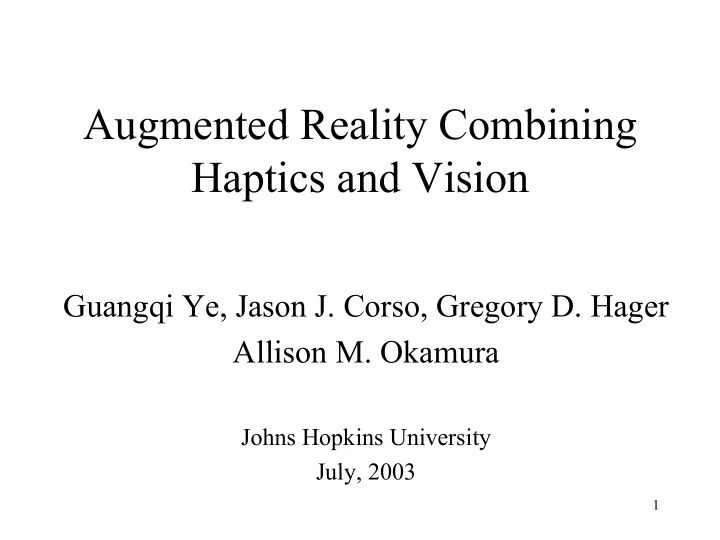

Augmented Reality Combining Haptics and Vision Guangqi Ye, Jason J. Corso, Gregory D. Hager Allison M. Okamura Johns Hopkins University July, 2003 1
Vision + Haptics 2
Outline of the Talk • Motivation • System Framework • Implementation Details • Experimental Results • Short Videos and Conclusion 3
Cons of Constant Contact • Prevents feeling of new tactile sensation • Limited workspace of haptic device PHANToM 1.0A: 13 cm * 18 cm * 25 cm • Constant reminder of “a virtual world” 4
Our Solution: Combining Vision • Project Goal: integrating force feedback and tactile feedback 5
Advantages of Our System • Combining force feedback and tactile feedback • User-friendly • Immersiveness 6
Modular Framework • Three modules Vision, Haptic device, augmented reality • Vision: Tracking the user’s fingertip • Haptic device : Meeting the user and Interaction rendering • Augmented Reality Scene configuration Vision/Haptics 3-D registration 7
Vision Subsystem • Hand Segmentation • Fingertip Detection • Fingertip Tracking 8
Segmentation of Hand • Appearance Model: Hue Histogram • Classification Criterion: histogram matching n ∑ min( Measure , Model ) i i = = i 1 HI ( Measure , Model ) n ∑ Model i = i 1 • Skin color model Single Gaussian model of hue distribution • Accuracy: 98% 9
Segmentation Example 10
Fingertip Detection • Geometrical Properties of Fingertip True Fingertip False Fingertip 11
Fingertip Detection Example 12
Fingertip Tracking • Kalman Filter • Search for fingertip in a local area • 3-D coordinates calculation 13
Augmented Reality Module • 3-D registraction • Calculate R and t Optimal solution of absolute orientation • Precision: 0.5mm 14
Augmented Reality Module • Scene Configuration • Virtual plane (n, d) • Button (p, n, w, h) • Passive objects 15
Haptic Device Subsytem • Control Law 16
Gravity Compensation • Torque of gravity of PHANToM parts • Force to compensate gravity 17
Interaction Simulation • Overall force control • Object gain matrix • Adjust gain along the normal to the surface 18
Model the Interaction 19
Experimental Results • Implementation on average PC • Around 12 fps • Multiple objects 20
Interaction Simulation Results 21
A Short Movie 22
Conclusion • Combine vision to resolve the problem of constant contact • Modular framework incorporating force feedback and tactile feedback • Key problems: visual tracking, 3-D registration, interaction rendering • Further research: HMD, richer interaction 23
• Thanks • Comments/Questions ? • Acknowledgements: The authors thank Jake Abbott for his assistance with PHANToM control. The work was supported in part by the Johns Hopkins University and National Science Foundation Grant #EEC- 9731478. 24
Recommend
More recommend